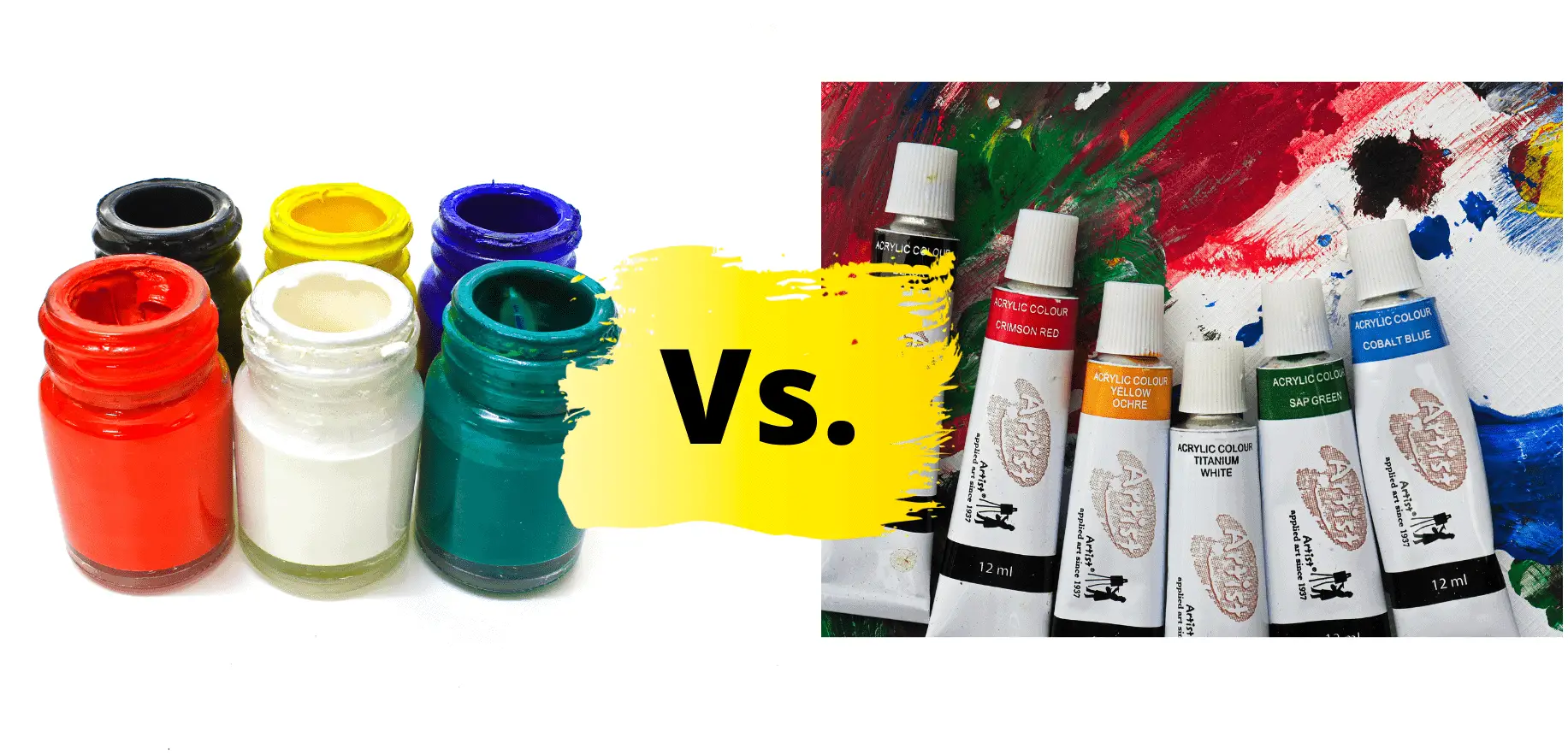When you go into an art store, there are so many art mediums to choose from like poster paint and acrylic paint. You might have noticed that poster paints are cheaper than acrylic paint. But what exactly is the difference between poster paint and acrylic paint?
In general, poster paints are made with school projects and temporary artwork in mind while acrylic paint is made as a safer and more convenient alternative to oil paints with both students and professional artists in mind. Poster paints are not permanent on a surface while acrylic paint is permanent after drying.
These paints differ in their composition, pricing, durability, and quality as they are made to achieve different purposes. Each of these differences will be discussed further in this article.
What is poster paint?
Poster paint (which is an inexpensive version of Tempera paint) is made with water-soluble binders such as gum arabic or gum water, starch, and cellulose. Thus they can be mixed with water before painting and redissolved after drying. They come in bottles, jars, or powdered forms. These paints are used for school art projects and are generally cheaper.
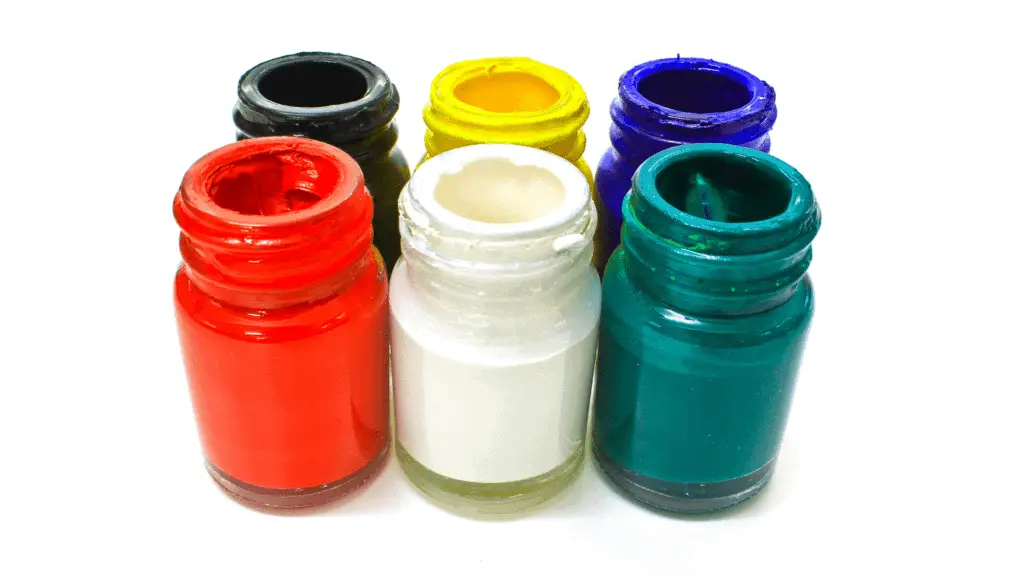
What is acrylic paint?
Acrylic paint is made with dry pigments suspended in a liquid acrylic polymer binder along with additives such as plasticizers, defoamers, silicone oils, and stabilizers. Most acrylic paints are water-based. Thus they are water-soluble and do not need thinners like oil for thinking. They can be thinned with water.
But after exposure to air, water evaporates and the paint dries quickly as a waterproof thin plastic layer. Because of this waterproof quality acrylics are used on a variety of surfaces like canvas, wood, windows, walls, and fabric
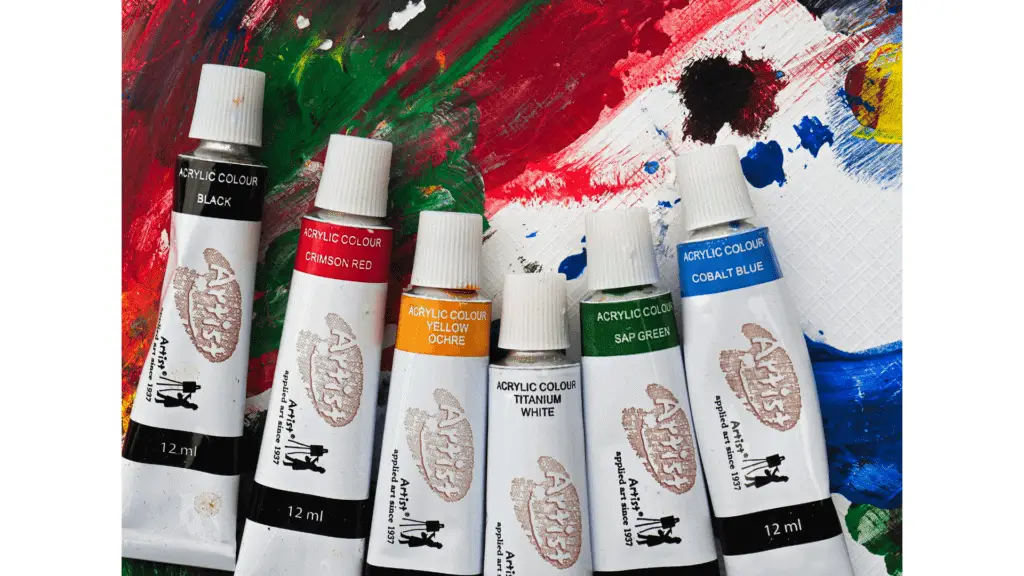
I have written a whole article comparing all the water-based paints to acrylic paint. You can find a detailed comparison of each water-based paint and acrylic paint including a nice summary with a handy chart.
Key differences between the poster and acrylic paint
I have summarized all the key differences between poster paints and acrylic paint in the following table.
| Aspect | Poster paint | Acrylic paint |
| Binders | Water-soluble binders such as gum water | Water-resistant acrylic polymer binder which is plastic |
| Pigments | Non-toxic, large pigments | Can be toxic if ingested (eg: cadmium), high-quality rare pigments |
| Usage | school art projects, usually not for displaying | Used by artists for displaying purposes |
| Price | Inexpensive | Expensive |
| Color lifting | colors lift relatively easily | Colors do not lift, colours are permanent after drying |
| Colors | Vibrant when used straight from the bottle, but usually muddy when colors are mixed | Excellent color mixing ability, a wide range of vivid and vibrant colors can be obtained |
| Layering | Difficult to paint in layers | Can easily paint in layers |
| Consistency | Usually comes as liquids and sometimes as powders | Usually comes as a liquid and can change consistency with mediums |
| Opacity | Opaque | Opaque, available in different opacities |
| Surface | Best on paper like watercolor paper | Most surfaces like canvas, wood, plastic metal |
| Finishing | Chalky finish | Soft glossy finish, It can be changed using mediums |
| Durability | Less durable | More durable |
I have explained in detail the difference between poster paint and acrylic paint regarding different aspects. To explain the differences better I have used yellow and red acrylic and poster colors.
I have tested each aspect with these two colors of poster and acrylic paints and will be sharing my experiences below. I used 80 gsm of normal paper as the surface since I did not have the watercolor paper on hand.
Binders
Both acrylic and poster paints are a combination of pigments and binders. But as previously mentioned poster colors have water-soluble binders like gum arabic. Acrylic colors have liquid acrylic polymer binder which is essentially plastic. Thus there is a water-resistant nature to acrylic while poster colors can be redissolved in water.
Pigments
The poster color pigment size is large and generally non-toxic. But acrylic colors can have toxic pigments such as cadmium. Therefore be careful when giving acrylics to youngsters. But generally, you are safe as long as you don’t eat your paint. Try not to hold your brushes too close to your mouth.
usage
Poster colors are good for school projects to practice painting. Children can enjoy painting with poster colors as they are thicker than watercolor in the application. They are generally non-toxic and safe to use by children.
Poster colors are used for scanning and reproduction rather than display. In other words, it is used for temporary artwork where durability for years is not a concern.
Both students and professional artists use acrylic. Initially, it was made as a safe and convenient alternative to oil paints. Acrylic paint can be used on almost any surface from canvas to paper to glass to metal.
price
Acrylic paints are more expensive. The prices depend on the pigments used. Artist-quality acrylics have high-quality pigments in high density. Therefore it has higher prices. Price may vary according to how expensive the pigments are and how difficult it is to find those pigments. Acrylics also come in student quality and craft quality. They have low pigment density and more filler. So they are relatively cheaper than artist-quality acrylics.
Poster colors are cheaper than most acrylic paints. This might be due to the lower-quality ingredients they use. Also, poster color hues are a combination of pigments. Meaning these are not pure pigments. But with artist-quality acrylics, there is one pure pigment that gives a particular color. For this reason, poster color paints are inexpensive.
Color lifting
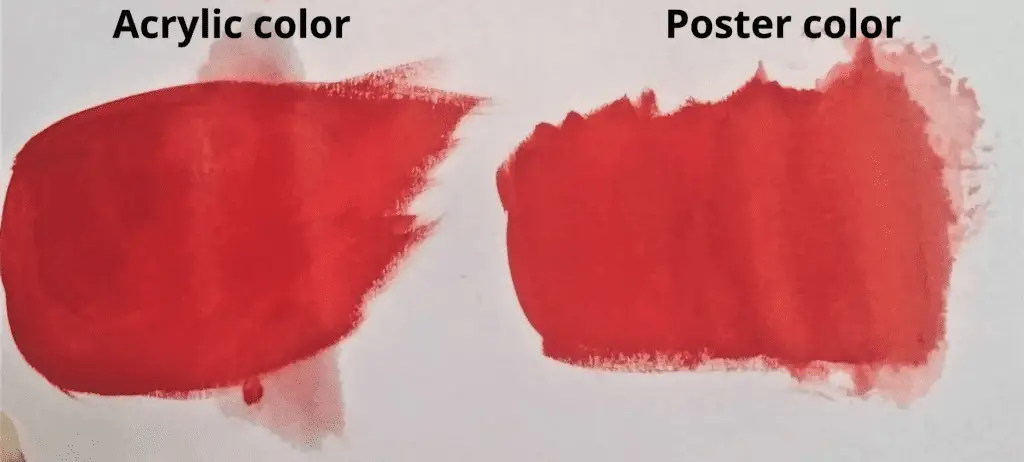
Color lifting is how easy it is to redissolve the paint with some water and remove the paint with a material like tissue paper. This is usually to get a white area to work on. Poster colors lift easily.
You can see in the image that poster colors dissolve in water and acrylic colors don’t. But I couldn’t remove them completely from the paper since I am using a normal 80 gsm paper.
On the other hand, acrylic colors cannot be lifted after drying. It cannot be redissolved and is impossible to lift. But if you want to correct a mistake or want to have a white area to work on, you can easily add a top paint layer. It will not disturb the paint layer underneath.
So you can say that poster paints are non-permanent and water-soluble even after drying. But acrylic paints are permanent and water-resistant after drying.
Color mixing
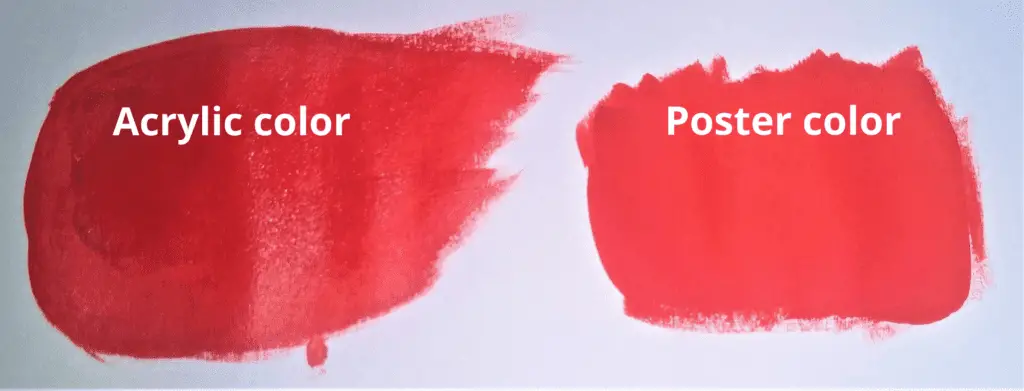
Poster colors are vibrant when used straight from the bottle. It is more like gouache. As some Poster colors are made up of multiple pigments, it is easier to make muddy colors and more desaturated colors when color mixing.
With acrylic paints the color mixing abilities are endless. You can make any color by mixing. However, as acrylics dry faster you will not have much blending capacity on the canvas (oil paints have super color blending ability on canvas as it does not dry fast)
Layering
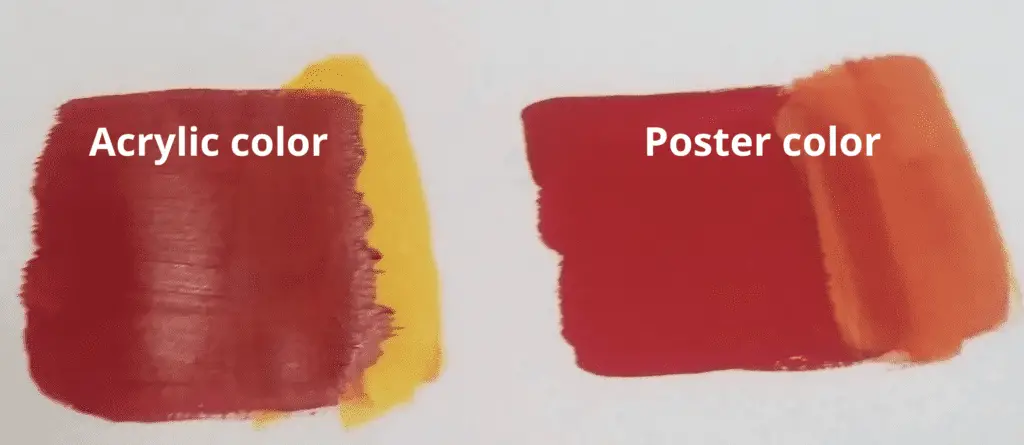
As poster colors can be redissolved in the water it is difficult to apply layers of poster paints on top of each other. You will mix the layers and make a muddy color. However, it may be possible if you use thick paint for layers.
The best thing about acrylic is that it can be applied in layers. The paint dries quickly and is waterproof after drying. So the top layer does not disturb the bottom layer.
Consistency
Both acrylics and poster paints have a similar consistency. They both come as liquids. Poster colors can come in powdered forms also. Also, acrylic paint can be a little thicker than poster paint. With acrylics, you can adjust the consistency. You can make the paint thick, textured, creamy, and gel-like consistency. All by mixing the acrylic paint with different mediums.
Opacity
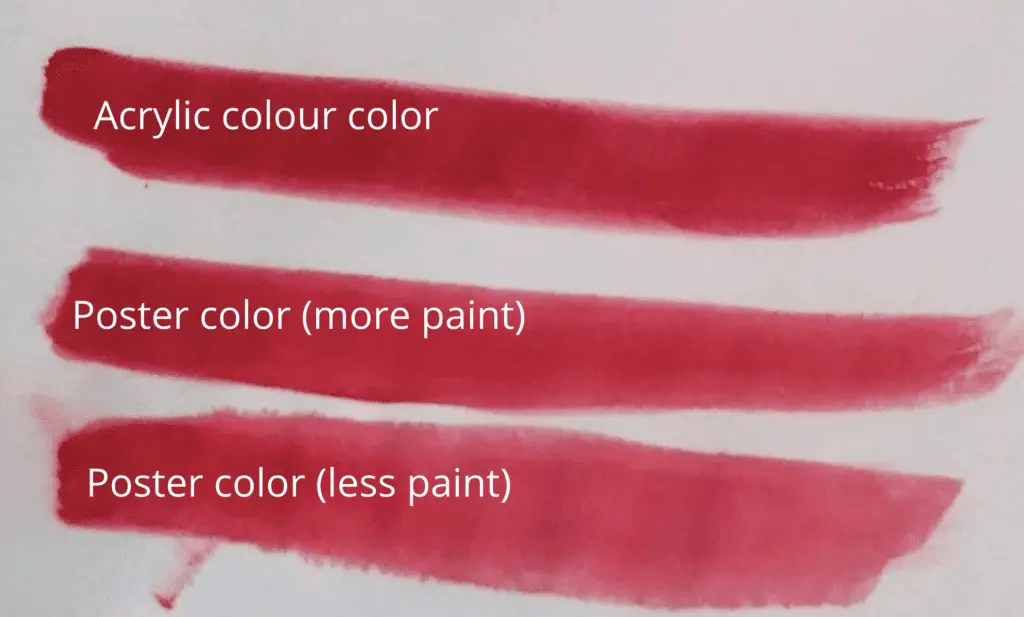
Opacity refers to how less transparent the paint looks on the painting’s surface. There is high opacity when it is hard to see the painting surface through the paint. Both acrylics and poster colors are opaque. The reason is that they have larger pigments. Opacity increases with increasing pigment size and other additives. These two paints can even be painted on colored surfaces due to their high opacity.
But you can buy acrylics in different opacities. You can have transparent to thick opaque acrylic paint. In artist-quality acrylics, you can check the tube label for opacity. But with poster colors, you do not have that option.
Painting surfaces
You can paint with acrylics on any surface such as canvas, wood, plastic metal, etc. The paint is durable if the surface is prepared well and the finished painting was sealed. Mostly acrylics are used on canvases. You can also buy canvas pads to practice painting. Get canvas sheets in yards and frame them later if needed. You can save some good bucks this way.
Always remember that you can reuse old acrylic-painted canvases.
Poster paints are better used on paper and boards. If doing a very thick application, use watercolor paper or paper above 160 gsm. The higher the gsm value, the thicker the paper would be and it will bulk less when a thick layer of paint is applied. However, any normal paper will work fine with poster color paints.
Finishing

There is a chalky finish to poster paint while acrylic has a soft glossy finish. However, you can manipulate the finishing of acrylics with different mediums. As an example, you can get a matte finish by, mixing acrylic with a matte medium.
Durability
Acrylic colors last longer without fading when exposed to sunlight. meaning they are lightfast. Especially when you add a protective topcoat to the finished painting such as varnish. Before painting also, make sure you prime the surface with gesso.
Poster color paintings are mostly scanned and reproduced. So they do not need to be displayed. Hence these paintings are not lightfast. The paints can be faded away when exposed to sunlight.
The bottom line
Poster paints are best for students for their art projects. They are best used on paper like watercolor paper and not on canvases. Poster colors are made for scanning and reproducing the content. So, it is harder to preserve poster paintings. But if you add a top coating it may be preserved. If you want long-lasting quality painting, go for acrylics.

